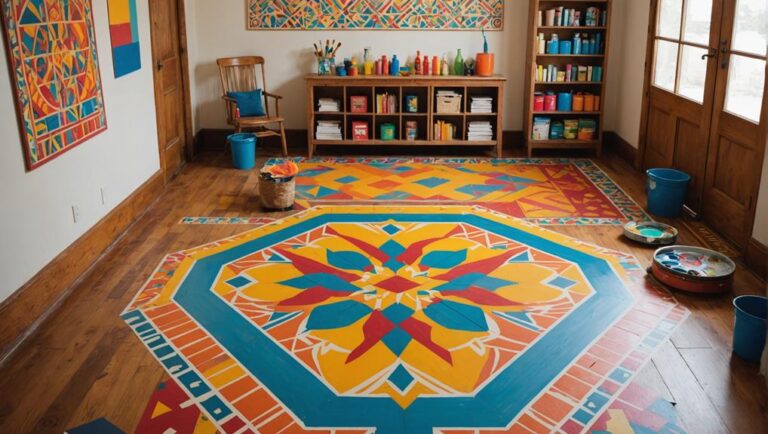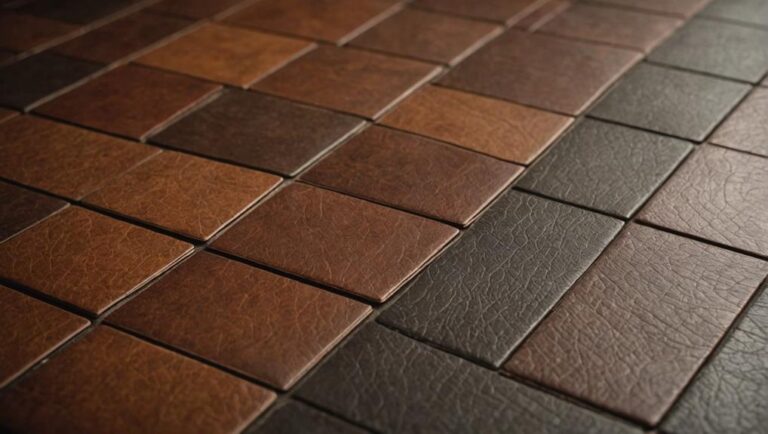To winter-proof your outdoor flooring, start by evaluating its condition for cracks, wear, or drainage issues. Choose materials like composite decking or natural stone that resist moisture and freezing temperatures. Clean surfaces thoroughly before winter, removing debris that can trap moisture. Apply appropriate sealants to enhance protection, making sure they cure completely. Install proper drainage solutions to prevent water pooling and ice formation. Use durable rugs at entry points to catch moisture, and maintain a snow and ice management routine. With regular inspections and prompt repairs, you'll guarantee your flooring withstands winter's challenges effectively. More insights await you.
Assessing Your Outdoor Flooring
How well is your outdoor flooring standing up to the elements? Evaluating its condition is essential for ensuring safety and longevity, especially during winter months when weather impact can be significant. Start by examining the surface for signs of wear and tear, such as cracks, splintering, or warping. These issues can indicate reduced flooring durability, increasing the risk of slips and falls.
Next, evaluate how well your flooring drains after rain or snow. Poor drainage can lead to water pooling, which not only decreases durability but also creates hazardous icy patches. If you notice water accumulation, consider installing drainage solutions or adjusting the slope of your flooring to promote better water runoff.
Additionally, inspect any joints or seams in your flooring. These areas are often more vulnerable to the weather's impact, especially if they weren't properly sealed or maintained. Look for gaps that could allow moisture to seep in, causing further deterioration. Regular maintenance, including resealing or treating your flooring, can enhance its resistance to the elements.
Lastly, think about the type of flooring material you've chosen. Some materials are inherently more durable against winter weather than others. While this discussion isn't about material selection, understanding how your current flooring holds up can inform future decisions.
Choosing the Right Materials
Selecting the right materials for outdoor flooring is essential for guaranteeing durability and safety during winter months. When you're choosing materials, consider options that withstand freezing temperatures, moisture, and potential slips. Two strong contenders are composite decking and natural stone.
Composite decking is a popular choice due to its resistance to warping, splintering, and fading. Made from a blend of wood fibers and recycled plastics, it doesn't absorb water, reducing the risk of mold and mildew during winter. Additionally, its textured surface can provide better traction, minimizing the risk of slips and falls on icy surfaces. When selecting composite decking, look for products specifically designed for cold climates, as these will have added durability features.
On the other hand, natural stone offers a timeless aesthetic and exceptional strength. Materials like granite, slate, or limestone can withstand harsh winter conditions without cracking or degrading. However, you'll want to verify that the stone is properly sealed to prevent water infiltration, which can freeze and cause damage. Be mindful of the stone's surface finish; a textured finish can enhance grip, offering safety against slipping.
Ultimately, the right choice depends on your specific environment and aesthetic preferences. Whether you opt for composite decking or natural stone, prioritize materials that enhance safety, durability, and ease of maintenance throughout those challenging winter months.
Cleaning Before Winter Arrives
Preparing your outdoor flooring for winter is essential for maintaining its integrity and safety. One of the first steps on your pre-winter checklist should be a thorough cleaning of your outdoor surfaces. This not only prevents the buildup of debris that can trap moisture but also helps to identify any potential issues that could worsen during colder months.
Start by using appropriate outdoor cleaning techniques tailored to your flooring material. For concrete or stone, a pressure washer can effectively remove dirt and grime. Confirm you use a nozzle that creates a wide spray to avoid damaging the surface. For wooden decks, a gentle scrub with a mixture of soap and water, followed by rinsing, will help eliminate mold and mildew. Remember to address any existing stains; they can become more difficult to remove once winter sets in.
After cleaning, allow the surfaces to dry completely. Moisture trapped under snow or ice can lead to warping or cracking, especially in wooden materials. It's also wise to inspect for any signs of wear, such as loose boards or cracks, and schedule repairs before winter fully arrives.
Applying Protective Sealants
What steps should you take to guarantee your outdoor flooring is well-protected for the harsh winter months? Applying protective sealants is essential for safeguarding your surfaces against moisture, ice, and freezing temperatures. To start, you'll need to choose the right sealant types. There are various options available, such as penetrating sealants, which absorb into the material, and topical sealants that create a protective layer on the surface. For concrete, a penetrating sealant is often recommended, while wood surfaces are best served by a topical sealant that enhances durability.
Next, preparation is key. Verify your flooring is clean and dry before application. This means removing any debris, dirt, or existing sealants that could interfere with adhesion. Once your surface is ready, apply the sealant using appropriate application techniques. A roller or brush is typically suitable for large areas, while a spray application may be more effective for intricate patterns or hard-to-reach spots.
Make sure to follow the manufacturer's instructions regarding the number of coats and drying times. Generally, two coats provide maximum protection. After applying the sealant, allow sufficient time for it to cure completely before exposing the surface to winter elements.
Installing Drainage Solutions
When it comes to winter-proofing your outdoor flooring, installing effective drainage solutions is vital for preventing water accumulation and ice formation. Poor water flow can lead to hazardous conditions, so it's imperative to implement proper drainage systems to guarantee safety and longevity of your flooring.
Here are three effective drainage solutions you should consider:
- French Drains: These systems consist of a trench filled with gravel and a perforated pipe that redirects water away from your outdoor area. They're particularly effective for managing excess water and preventing pooling.
- Channel Drains: These linear drainage systems collect surface water and direct it away from your flooring. They're ideal for driveways, patios, and walkways where water tends to accumulate. Proper installation guarantees that water flows smoothly through the channels, reducing the risk of ice formation.
- Sump Pumps: If you're dealing with a low-lying area, a sump pump can be a lifesaver. These pumps remove water that collects in a sump basin, helping to maintain the desired water flow around your outdoor space.
Using Rugs and Mats
Rugs and mats are essential tools for enhancing the safety and comfort of your outdoor flooring during winter months. They can help prevent slips and falls, especially when surfaces are wet or icy. When choosing rugs, consider materials that are durable and weather-resistant, such as polypropylene or rubber, to withstand harsh conditions.
Selecting the right rug patterns can also play a role in safety. Opt for designs that feature contrasting colors, as these can increase visibility and help you identify potential hazards more easily. Additionally, textured surfaces on rugs provide extra grip, reducing the risk of slipping.
Mat placement is critical for maximizing safety. Strategically position mats at entry points, such as doorways or patios, to catch moisture and debris, minimizing the chance of water pooling on your flooring. It's advisable to use larger mats that cover more area, ensuring that they effectively absorb any snow or water before it reaches your floors.
Regularly inspect your rugs and mats for wear and tear, as damaged mats can pose safety risks. Clean them frequently to remove any ice, snow, or dirt buildup that could lead to slipping.
Snow and Ice Management
Managing snow and ice effectively is essential for maintaining the safety and usability of your outdoor flooring during winter months. Failure to properly manage these elements can lead to hazardous conditions, leading to slips and falls. To guarantee a safe environment, you'll want to implement a solid snow and ice management plan.
Here are three key practices to follow:
- Snow Removal: Regularly clear snow from your outdoor flooring as soon as possible. Use a snow shovel or a snow blower designed for your surface type to prevent compacted snow that can turn into ice. This proactive approach reduces the risk of injury and prolongs the life of your flooring.
- Ice Melt Application: Use an ice melt product suitable for your flooring material. Make sure to choose one that won't cause damage, especially on surfaces like pavers or wood. Apply it promptly to prevent ice formation and guarantee safe passage.
- Monitoring Weather Conditions: Stay updated on weather forecasts, especially when snow or ice is predicted. Preparing in advance allows you to schedule snow removal and ice melt application, keeping your flooring safe and accessible.
Regular Maintenance Tips
To keep your outdoor flooring in top shape throughout the winter, regular maintenance is essential. Start by conducting seasonal inspections. These inspections should focus on identifying any damage or wear that could worsen over the cold months. Look for cracks, loose tiles, or warped boards, as these issues can compromise safety and stability.
Once you've identified potential problems, implement appropriate repair techniques. For example, if you notice cracks in concrete or pavers, fill them with a quality patching compound designed for outdoor use. This prevents moisture infiltration, which can lead to further deterioration. If you have wooden decking, check for rotting or splintering. Sand down any rough areas and apply a weather-resistant sealant to protect against moisture and freezing temperatures.
Additionally, keep your outdoor flooring clean and free of debris. Regular sweeping and washing can help prevent the buildup of ice and snow, which can be hazardous. If you live in an area with heavy snowfall, consider using a snow shovel or a plastic snow blower instead of metal tools, as they can scratch and damage the surface.
Frequently Asked Questions
How Can I Tell if My Flooring Needs Replacement?
To determine if your flooring needs replacement, keep an eye out for several signs. If you notice deep scratches, cracks, or warping, it's time to assess its condition. Additionally, consider the flooring lifespan; most materials have a specific duration. If your flooring is nearing the end of that lifespan and shows wear, it's wise to think about replacement. Safety's essential, so don't ignore any potential hazards from damaged flooring.
Are There Specific Colors That Resist Heat Absorption in Winter?
Yes, certain colors can impact heat absorption markedly. Lighter colors, like white or beige, reflect more sunlight, enhancing thermal efficiency during winter. Conversely, darker colors absorb heat, which might be beneficial in colder months but can lead to overheating in warmer seasons. When selecting materials, consider how color will affect not just aesthetics but also safety and comfort, ensuring your space remains usable and pleasant throughout the year.
What Are the Signs of Water Damage in Outdoor Flooring?
When it comes to outdoor flooring, the signs of water damage can be downright dramatic! You might notice unsightly water stains that seem to spread like wildfire. If you see mold growth, it's a clear red flag that moisture's taken hold. Look for warped or buckled boards, too—those'll scream for your attention. To keep your outdoor space safe, act fast if you spot any of these issues; ignoring them could lead to bigger problems.
Can I Winter-Proof My Flooring DIY or Should I Hire Professionals?
You can winter-proof your flooring using DIY techniques, but it's essential to assess your skills and the complexity of the project. Simple tasks like sealing and applying protective coatings might be manageable for you. However, if you're unsure or the flooring's condition is severe, hiring professional services might be the safer option. They have the expertise to guarantee the job's done correctly, preventing potential damage and making sure your flooring lasts through harsh winters.
How Often Should I Inspect My Outdoor Flooring in Winter?
You might be wondering just how often you should inspect your outdoor flooring during winter. It's essential to make seasonal maintenance a priority. Ideally, check your flooring materials every couple of weeks, looking for signs of wear, ice accumulation, or damage. If you spot any issues, don't wait—address them promptly. Regular inspections can help prevent accidents and extend the lifespan of your flooring, ensuring safety and stability throughout the winter months.




